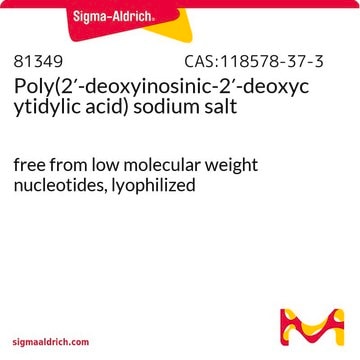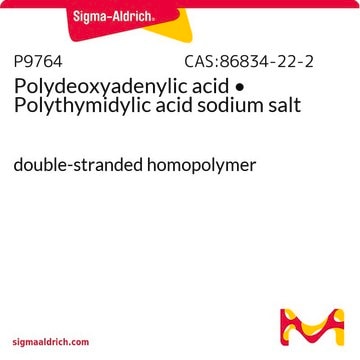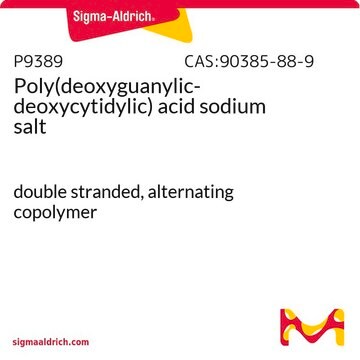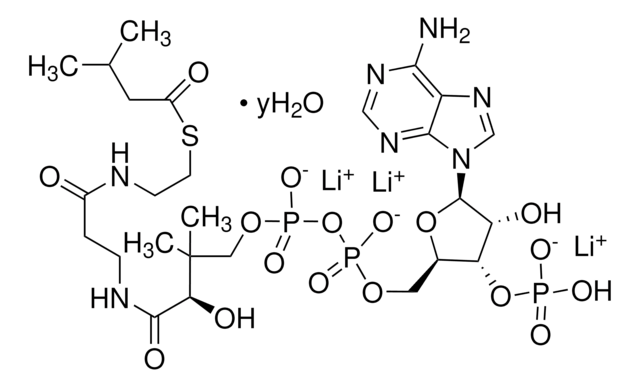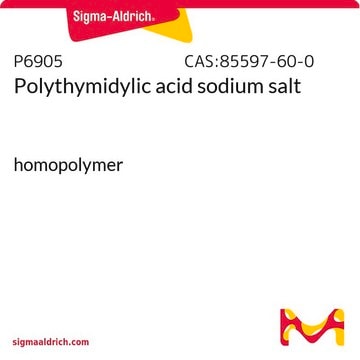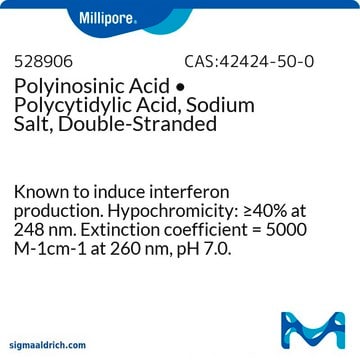P4929
Polydesoxyinosindesoxycytidinsäure Natriumsalz
double-stranded alternating copolymer
Synonym(e):
Poly(dI-dC) • Poly(dI-dC) Natriumsalz
Anmeldenzur Ansicht organisationsspezifischer und vertraglich vereinbarter Preise
Alle Fotos(1)
About This Item
Empfohlene Produkte
Suchen Sie nach ähnlichen Produkten? Aufrufen Leitfaden zum Produktvergleich
Anwendung
Polydesoxyinosindesoxycytidinsäure (Poly(dI-dC) • Poly(dI-dC)) ist ein alternierendes Copolymer, das als DNA-Substrat zur Beurteilung von DNA-Methyltransferasen wie der DNA-Methyltransferase 1 sowie als doppelsträngiges DNA-Modell für Konformationsstudien zur Dynamik der DNA-Struktur und der Wechselwirkungen mit kleinen Arzneimittelmolekülen dient.
Polydesoxyinosindesoxycytidinsäure-Natriumsalz wurde im Electrophoretic Mobility Shift Assay mit p65-Protein und Neuro-2A-Proteinlysat verwendet. Es wurde auch als Substrat in Protein-Arginin-Methyltransferase-1(PRMT1)- und DNA-Methyltransferase-1(DNMT1)-Selektivitätsassays verwendet.
Polydesoxyinosindesoxycytidinsäure-Natriumsalz wurde in einer Studie verwendet, in der Bis(2-(pyrimidin-2-γl)ethoxy)alkane synthetisiert und ihre pharmakologische Aktivität charakterisiert wurde. Polydesoxyinosindesoxycytidinsäure-Natriumsalz kam außerdem in einer Studie zum Einsatz, in der das Wachstum von Calciumcarbonat-Filmen auf LB/LbL-Matrizen untersucht wurde.
Biochem./physiol. Wirkung
Poly(2′-desoxyinosin-2′-desoxycytidinsäure), Poly(dI-dC) ist ein synthetisches DNA-Substrat. Bei hohen Salzkonzentrationen liegt Poly(dI-dC) in einer linksgewendelten Helixkonformation vor und kehrt bei abnehmender Salzkonzentration in die rechtsgewendelte Form zurück. Es wird im Electrophoretic Mobility Shift Assay (EMSA) eingesetzt.
Sonstige Hinweise
Doppelsträngiges alternierendes Copolymer
Einheitendefinition
Eine Einheit liefert ein A260 von 1,0 in 1,0 ml 20 mM Natriumphosphat/100 mM NaCl, pH 7,0 (1 cm Lichtweg)
Lagerklassenschlüssel
11 - Combustible Solids
WGK
WGK 3
Flammpunkt (°F)
Not applicable
Flammpunkt (°C)
Not applicable
Persönliche Schutzausrüstung
Eyeshields, Gloves, type N95 (US)
Analysenzertifikate (COA)
Suchen Sie nach Analysenzertifikate (COA), indem Sie die Lot-/Chargennummer des Produkts eingeben. Lot- und Chargennummern sind auf dem Produktetikett hinter den Wörtern ‘Lot’ oder ‘Batch’ (Lot oder Charge) zu finden.
Besitzen Sie dieses Produkt bereits?
In der Dokumentenbibliothek finden Sie die Dokumentation zu den Produkten, die Sie kürzlich erworben haben.
Kunden haben sich ebenfalls angesehen
Identification of Selective, Cell Active Inhibitors of Protein Arginine Methyltransferase 5 through Structure-Based Virtual Screening and Biological Assays
Ye F, et al.
Journal of Chemical Information and Modeling, 58(5), 1066-1073 (2018)
Dimitrios Priftis et al.
Langmuir : the ACS journal of surfaces and colloids, 28(23), 8721-8729 (2012-05-15)
A systematic study of the interfacial energy (γ) of polypeptide complex coacervates in aqueous solution was performed using a surface forces apparatus (SFA). Poly(L-lysine hydrochloride) (PLys) and poly(L-glutamic acid sodium salt) (PGA) were investigated as a model pair of oppositely
Chao Bi et al.
Plant molecular biology, 94(1-2), 197-213 (2017-04-10)
It has been known that ABA INSENSITIVE 5 (ABI5) plays a vital role in regulating seed germination. In the present study, we showed that inhibition of the catalase activity with 3-amino-1,2,4-triazole (3-AT) inhibits seed germination of Col-0, abi5 mutants and
Ligang Fan et al.
Nature communications, 11(1), 4947-4947 (2020-10-04)
Pseudomonas syringae is a Gram-negative and model pathogenic bacterium that causes plant diseases worldwide. Here, we set out to identify binding motifs for all 301 annotated transcription factors (TFs) of P. syringae using HT-SELEX. We successfully identify binding motifs for
Meaghan L Clark et al.
Inorganic chemistry, 47(20), 9410-9418 (2008-09-25)
This paper focuses on DNA-binding interactions exhibited by Pt(dma-T)CN(+), where dma-T denotes 4'-dimethylamino-2,2':6',2''-terpyridine, and includes complementary studies of the corresponding pyrr-T complex, where pyrr-T denotes 4'-(N-pyrrolidinyl)-2,2':6',2''-terpyridine. The chromophores are useful for understanding the interesting and rather intricate DNA-binding interactions exhibited
Unser Team von Wissenschaftlern verfügt über Erfahrung in allen Forschungsbereichen einschließlich Life Science, Materialwissenschaften, chemischer Synthese, Chromatographie, Analytik und vielen mehr..
Setzen Sie sich mit dem technischen Dienst in Verbindung.
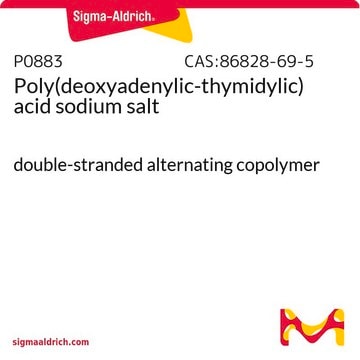
![Poly[d(I-C)] lyophilized, pkg of 10 U (10108812001 [A<sub>260</sub> units]), pkg of 50 U (11219847001 [A<sub>260</sub> units])](/deepweb/assets/sigmaaldrich/product/images/352/091/ef743cea-ccd8-44f1-8f3b-dec5a1e4f5d1/640/ef743cea-ccd8-44f1-8f3b-dec5a1e4f5d1.jpg)
